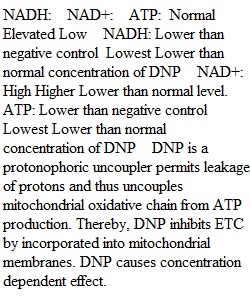


Q Critical Thinking 3 25 points Names Use short answer format to answer questions. All questions or sub-bullets are worth 1 point unless otherwise stated. 1. 2,4-Dinitrophenol (DNP) is a chemical that has been used in the early 1900s to cause weight loss. It has since been considered to be unsafe for human consumption and can lead to death. It causes a disruption of the oxidative phosphorylation of ATP. It causes the hydrogen ion gradient to become disrupted by allowing protons to leak back across the membrane and bypass ATP synthase. A) Predict how levels of each of the following would change in a person taking large amounts of the drug (normal/elevated/low). Explain why using the metabolic pathways we learned in class and where each of these are used and produced. (6 points) B) Facultative anaerobes are affected by 2,4-Dinitrophenol (DNP) but it takes higher levels of chemical to kill these organisms. That is because these organisms use what other process to recycle NADH back to NAD+ and produce ATP? (2 points)C) Other chemicals such as cyanide also disrupt the electron transport chain. Cyanide binds to the active site of on of the enzymes in the Electron Transport chain blocking its activity. What type of inhibition is described in the case of cyanide?2. A researcher has been working to identify single celled organisms that live in a saltwater environment on the coast of the Galapagos Islands. The researcher took several samples from different depths and isolated the cells. During the process the researcher became sick and the researcher’s family thought that the organisms the researcher was sampling had made the researcher sick. Given that these organisms dwell in the ocean (3.5% salinity) explain to the family why the researcher’s blood (0.9% salinity) would be an inhospitable site for this organism to dwell. Make sure you use the terms diffusion, osmosis, selectively permeable, and hypertonic, hypotonic, isotonic to explain your answer. (3 points)
View Related Questions